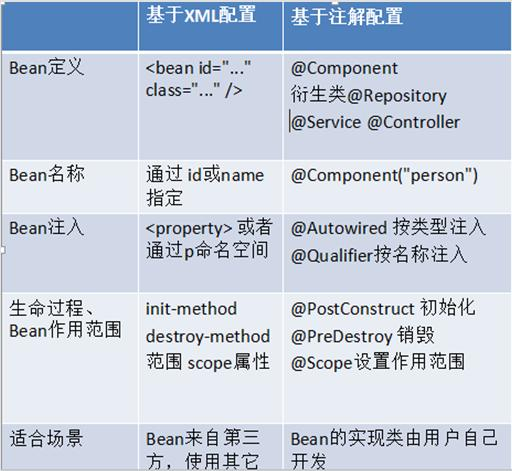Spring 基于注解的 IOC 配置
创建 spring 的 的 xml 配置 文件
<context:component-scan base-package="com.itheim"/> 指定创建容器时要扫描的包
<?xml version="1.0" encoding="UTF-8"?>
<beans xmlns="http://www.springframework.org/schema/beans"
xmlns:xsi="http://www.w3.org/2001/XMLSchema-instance"
xmlns:context="http://www.springframework.org/schema/context"
xsi:schemaLocation="http://www.springframework.org/schema/beans
http://www.springframework.org/schema/beans/spring-beans.xsd
http://www.springframework.org/schema/context
http://www.springframework.org/schema/context/spring-context.xsd">
<context:component-scan base-package="com.itheim"/>
</beans>
常用注解
用于创建对象的
@Component
相当于: <bean id="" class="">
作用:
把资源让 spring 来管理。相当于在 xml 中配置一个 bean。
属性:
value:指定 bean 的 id。如果不指定 value 属性,默认 bean 的 id 是当前类的类名。首字母小写
@Controller @Service @Repository
他们三个注解都是针对一个的衍生注解,他们的作用及属性都是一模一样的。
他们只不过是提供了更加明确的语义化。
@Controller :一般用于表现层的注解。
@Service :一般用于业务层的注解。
@Repository :一般用于持久层的注解。
细节:如果注解中有且只有一个属性 要赋值时是 ,且名称是 value ,value 在赋值是可以不写。
用于注入数据的
相当于: <property name="" ref=""><property name="" value="">
@Autowired
作用:
自动按照类型注入。当使用注解注入属性时,set方法可以省略。它只能注入其他 bean 类型。当有多个
类型匹配时,使用要注入的对象变量名称作为 bean 的 id,在 spring 容器查找,找到了也可以注入成功。找不到
就报错。
@Qualifier
作用:
在自动按照类型注入的基础之上,再按照 Bean 的 id 注入。它在给字段注入时不能独立使用,必须和
@Autowire 一起使用;但是给方法参数注入时,可以独立使用。
属性:
value:指定 bean 的 id。
@Resource
作用:
直接按照 Bean 的 id 注入。它也只能注入其他 bean 类型。
属性:
name:指定 bean 的 id。
@Value
作用:
注入基本数据类型和 String 类型数据的
属性:
value:用于指定值 value值的方式 ${jdbc.url}
用于改变作用范围的:
相当于: <bean id="" class="" scope="">
@Scope
作用:
指定 bean 的作用范围。
属性:
value:指定范围的值。
取值:singleton prototype request session globalsession
和生命周期相关的:( 了解)
相当于: <bean id="" class="" init-method="" destroy-method="" />
@PostConstruct
用于指定初始化方法
@PreDestroy
用于指定销毁方法
关于 Spring 注解和 XML 的选择问题
注解的优势:
配置简单,维护方便(我们找到类,就相当于找到了对应的配置)。
XML 的优势:
修改时,不用改源码。不涉及重新编译和部署。
Spring 管理 Bean 方式的比较:

案例
通过注解实现从数据库查询信息
bean.xml配置
<?xml version="1.0" encoding="UTF-8"?>
<beans xmlns="http://www.springframework.org/schema/beans"
xmlns:xsi="http://www.w3.org/2001/XMLSchema-instance"
xsi:schemaLocation="http://www.springframework.org/schema/beans
http://www.springframework.org/schema/beans/spring-beans.xsd">
<bean id="accountService" class="com.itheim.service.Imp.accountServiceImp">
<property name="dao" ref="dao"/>
</bean>
<bean id="dao" class="com.itheim.dao.Imp.accountDaoImp">
<property name="runner" ref="runner"/>
</bean>
<bean id="runner" class="org.apache.commons.dbutils.QueryRunner" scope="prototype">
<constructor-arg name="ds" ref="ds"/>
</bean>
<!-- 配置数据源-->
<bean id="ds" class="com.mchange.v2.c3p0.ComboPooledDataSource">
<property name="driverClass" value="com.mysql.jdbc.Driver"/>
<property name="jdbcUrl" value="jdbc:mysql://localhost:3306/eesy_mybatis"/>
<property name="user" value="root"/>
<property name="password" value="root"/>
</bean>
</beans>
使用Service注解配置管理资源
/**
* 账户的业务层实现类
* @author
* @Company
* @Version 1.0
*/
@Service("accountService")
public class accountServiceImp implements accountService {
private accountDao dao;
static {
System.out.println("service创建完成");
}
public void setDao(accountDao dao) {
this.dao = dao;
}
public List<Account> findAll() {
return dao.findAll();
}
public void Update(int id) {
dao.Update(id);
}
public void saveUser(Account account) {
dao.saveUser(account);
}
}
/**
* 账户的持久层实现类
* @author
* @Company
* @Version 1.0
*/
public class accountDaoImp implements accountDao {
private QueryRunner runner;
public void setRunner(QueryRunner runner) {
this.runner = runner;
}
public List<Account> findAll() {
try {
String sql="select * from account";
return runner.query(sql,new BeanListHandler<Account>(Account.class));
} catch (SQLException e) {
throw new RuntimeException(e);
}
}
public void Update(int id) {
try {
String sql="update account set money=? where id=? ";
runner.update(sql,7000,id);
} catch (SQLException e) {
throw new RuntimeException(e);
}
}
public void saveUser(Account account) {
try {
String sql="insert into account(money) values(?)";
runner.update(sql,account.getMoney());
} catch (SQLException e) {
throw new RuntimeException(e);
}
}
}
注意:
1、当我们使用注解注入时,set 方法不用写
编写测试类
@Test
public void springTest(){
ApplicationContext context=new ClassPathXmlApplicationContext("bean.xml");
accountService service = (accountService) context.getBean("accountService");
Account account = (Account) context.getBean("account");
List<Account> list = service.findAll();
System.out.println(list);
account.setMoney(6000);
service.saveUser(account);
}
pom.xml下的配置为
<dependencies>
<dependency>
<groupId>mysql</groupId>
<artifactId>mysql-connector-java</artifactId>
<version>5.1.6</version>
</dependency>
<!--导入spring依赖jar包-->
<dependency>
<groupId>org.springframework</groupId>
<artifactId>spring-context</artifactId>
<version>5.0.2.RELEASE</version>
</dependency>
<dependency>
<groupId>junit</groupId>
<artifactId>junit</artifactId>
<version>4.12</version>
</dependency>
<dependency>
<groupId>c3p0</groupId>
<artifactId>c3p0</artifactId>
<version>0.9.1.2</version>
</dependency>
<dependency>
<groupId>commons-dbutils</groupId>
<artifactId>commons-dbutils</artifactId>
<version>1.7</version>
</dependency>
</dependencies>
Spring 基于注解的 IOC 配置的更多相关文章
- 10 Spring框架--基于注解的IOC配置
1.工程环境搭建 2.基于注解的IOC配置 IOC注解的分类 (1)用于创建对象的 他们的作用就和在XML配置文件中编写一个<bean>标签实现的功能是一样的@Component: 作用: ...
- spring基于注解的IoC以及IoC的案例
1.Spring中IoC的常用注解 1.1明确: (1)基于注解的配置和xml的配置要实现的功能都是一样的,都是要降低程序之间的耦合,只是配置的形式不一样 2.案例:使用xml方式和注解方式实现单表的 ...
- 阶段3 2.Spring_08.面向切面编程 AOP_9 spring基于注解的AOP配置
复制依赖和改jar包方式 src下的都复制过来. 复制到新项目里了 bean.xml里面复制上面一行代码到下面.把aop改成context. 配置spring容器创建时要扫描的包 Service的配置 ...
- 基于注解的IOC配置
1 明确 注解配置和XML配置要实现的功能都是一样的,都是要降低程序间的耦合.只是配置的形式不一样. 关于实际的开发中到底是使用XML还是注解,每家公司有着不同的习惯.具体问题具体分析. 2 环境搭建 ...
- spring的基于注解的IOC配置
1.配置文件配置 <?xml version="1.0" encoding="UTF-8"?><beans xmlns="http: ...
- spring基于注解的IOC
曾经的XML配置: <bean id="accountService" class="com.itheima.service.impl.AccountService ...
- 缓存初解(五)---SpringMVC基于注解的缓存配置--web应用实例
之前为大家介绍了如何使用spring注解来进行缓存配置 (EHCache 和 OSCache)的简单的例子,详见 Spring基于注解的缓存配置--EHCache AND OSCache 现在介绍一下 ...
- 缓存初解(三)---Spring3.0基于注解的缓存配置+Ehcache和OScache
本文将构建一个普通工程来说明spring注解缓存的使用方式,关于如何在web应用中使用注解缓存,请参见: Spring基于注解的缓存配置--web应用实例 一.简介 在spring的modules包中 ...
- 8 -- 深入使用Spring -- 4...5 AOP代理:基于注解的“零配置”方式
8.4.5 基于注解的“零配置”方式 AspectJ允许使用注解定义切面.切入点和增强处理,而Spring框架则可识别并根据这些注解来生成AOP代理.Spring只是使用了和AspectJ 5 一样的 ...
随机推荐
- NameNode是如何存储元数据的?
1.NN的作用 保存HDFS上所有文件的元数据! 接受客户端的请求! 接受DN上报的信息,给DN分配任务(维护副本数)! 2.元数据的存储 元数据存储在fsiamge文件+edits文件中! fsim ...
- redis(十六):Redis 安装,部署(LINUX环境下)
第一步:下载安装包 访问https://redis.io/download 到官网进行下载.这里下载最新的4.0版本. 第二步:安装 1.通过远程管理工具,将压缩包拷贝到Linux服务器中,执行解压 ...
- ajax+jquery+JSON笔记
ajax (asynchronous javascript and xml -- 基于javascript和xml的异同步通讯技术) 特征: 异步通讯 异步的请求-响应模式 1.传统的 ...
- cas-server-3.5.2-release.zip 及cas-client-3.2.1-release.zip下载
cas-client-3.2.1-release.zip===> https://github.com/apereo/cas/releases/download/v3.5.2/cas-serve ...
- OSCP Learning Notes - Kali Linux
Install Kali Linux : https://www.kali.org/ Common Commands: pwd man ls ls -la cd mkdir rmdir cp mv l ...
- 扩展BSGS
\(BSGS\) 求解\(a^x\equiv b\pmod p\),且\(a\)与\(p\)互质 由\(a^{φ(p)}\equiv1 \pmod p\)和\(a^0\equiv 1\pmod p\) ...
- python thrift 实现 单端口多服务的过程
Thrift 是一种接口描述语言和二进制通信协议.以前也没接触过,最近有个项目需要建立自动化测试,这个项目之间的微服务都是通过 Thrift 进行通信的,然后写自动化脚本之前研究了一下. 需要定义一个 ...
- C++与正则表达式入门
什么是正则表达式? 正则表达式是一组由字母和符号组成的特殊文本, 当你想要判断许多字符串是否符合某个特定格式:当你想在一大段文本中查找出所有的日期和时间:当你想要修改大量日志中所有的时间格式,在这些情 ...
- Kubernetes实战总结 - DevOps实现
一.概述 Git:一个开源的分布式版本控制系统,可以有效.高速地处理从很小到非常大的项目版本管理. Jenkins:一个开源软件项目,是基于Java开发的一种持续集成工具,用于监控持续重复的工作. M ...
- Jmeter性能测试使用指南
图床如果失效,可以关注二维码,公众号查阅. JMeter安装 1.下载地址: https://downloads.apache.org//jmeter/binaries/apache-jmeter-5 ...
